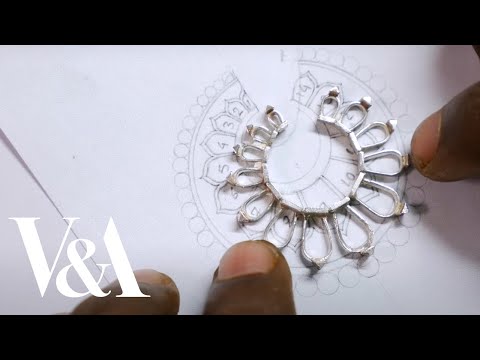Sparkle Your Career: Jewellery Designer Job Description & Salary

Jewellery Designer Job Description Template
Jewellery Designer Job Description A jewellery designer is a professional who creates and designs various types of jewellery pieces, such as necklaces, bracelets, earrings, and rings. They are responsible for conceptualizing and developing unique designs that meet the needs and preferences of their clients. Creativity is one of the most important skills required for this position. Jewellery designers must have a keen eye for detail and a strong sense of aesthetics. They must be able to come up with innovative designs that are visually appealing and marketable. Technical proficiency is another crucial skill for jewellery designers. They must be knowledgeable about different metals, gemstones, and other materials used in jewellery making. They should also have a good understanding of various jewellery design techniques, such as carving, casting, and setting stones. In addition to designing new pieces, jewellery designers may also be responsible for making adjustments or repairs to existing jewellery items. They often work closely with clients to understand their specific requirements and preferences. Collaboration is an important aspect of this job. Jewellery designers may work in collaboration with manufacturers, gemstone suppliers, and other professionals in the industry to bring their designs to life. Attention to detail and excellent craftsmanship are essential qualities for a successful jewellery designer. They must be able to transform their ideas into tangible, high-quality pieces of jewellery. Overall, a jewellery designer plays a key role in the fashion and luxury industry. Their designs often reflect current trends and styles, and they have the ability to create unique and timeless pieces that are cherished by their clients.Jewellery Designer Responsibilities
Jewellery Designer Requirements
How Much Does A Jewellery Designer Make?
Jewellery Designer Salary
| Experience Level | Average Salary |
|---|---|
| Entry Level | $30,000 – $40,000 per year |
| Mid-Level | $40,000 – $60,000 per year |
| Experienced | $60,000 – $80,000 per year |
| Senior | $80,000 – $100,000+ per year |
A jewellery designer’s salary varies based on their experience level. Entry-level designers can expect to earn an average of $30,000 to $40,000 per year. As they gain more experience and skills, their salary can increase to an average of $40,000 to $60,000 per year at the mid-level. Experienced jewellery designers with a solid portfolio can earn around $60,000 to $80,000 per year. Senior jewellery designers who have established themselves in the industry can make $80,000 or more per year, depending on their expertise and reputation.
Jewellery Designer Salaries by Country
Top Paying Countries for Jewellery Designer
| Country | Average Salary (USD) |
|---|---|
| United States | 70,000 |
| Switzerland | 65,000 |
| Australia | 60,000 |
| Canada | 55,000 |
| United Kingdom | 50,000 |
A jewellery designer’s salary can vary significantly depending on the country they work in. The table above showcases the top paying countries for jewellery designers. The United States offers the highest average salary at $70,000, followed by Switzerland at $65,000 and Australia at $60,000. Canada and the United Kingdom also provide competitive salaries for jewellery designers, with average earnings of $55,000 and $50,000 respectively. It is important to note that these figures are approximate and can vary depending on factors such as experience, skill level, and the specific employer. Overall, these countries offer attractive compensation for jewellery designers, making them desirable destinations for professionals in the field.
A video on the topic Jewellery Designer
Video Source : Victoria and Albert MuseumInterview Questions for Jewellery Designer
1. Can you tell us about your background and experience as a jewellery designer?
I have always been fascinated by the art of jewellery making, and I pursued a formal education in jewellery design. I have a degree in Fine Arts with a specialization in jewellery design, and I have been working in the industry for over five years. During this time, I have had the opportunity to work with various materials, techniques, and styles to create unique and exquisite jewellery pieces.
2. What inspires your designs?
I find inspiration in various sources such as nature, architecture, cultural heritage, and even personal experiences. I believe that inspiration can be found everywhere if you have a keen eye. I often incorporate organic shapes, vibrant colors, and intricate details in my designs to create pieces that are both visually appealing and meaningful.
3. How do you approach the design process?
My design process usually starts with extensive research and gathering of ideas. I create mood boards, sketch initial concepts, and experiment with different materials and techniques. I also take into consideration the client’s preferences and requirements if the design is custom-made. Once I have a clear vision, I proceed with handcrafting the jewellery piece while paying attention to every detail to ensure a high-quality final product.
4. What materials do you enjoy working with the most?
I enjoy working with a variety of materials as each one offers its own unique characteristics. However, I particularly enjoy working with precious metals such as gold and silver, as well as gemstones like diamonds, emeralds, and sapphires. These materials allow me to create luxurious and timeless pieces that can be cherished for generations.
5. How do you stay updated with current jewellery trends?
I believe it is essential for a jewellery designer to stay updated with current trends to meet the evolving demands of the market. I regularly attend industry trade shows, exhibitions, and fashion events to familiarize myself with the latest trends and techniques. I also follow fashion blogs, magazines, and social media platforms to stay connected with the latest jewellery designs and styles.
6. Can you describe a challenging project you have worked on and how you overcame it?
I once had a challenging project where a client wanted a custom-made engagement ring with a unique design that incorporated elements from their cultural heritage. It required extensive research and understanding of their culture to ensure the design accurately represented their traditions. I collaborated closely with the client, listened to their feedback, and made several iterations until we achieved the desired result. The end product was a beautiful and meaningful engagement ring that exceeded their expectations.
7. How do you ensure the quality and durability of your jewellery pieces?
Quality and durability are of utmost importance in jewellery design. I ensure this by using high-quality materials sourced from reputable suppliers. I also pay meticulous attention to the craftsmanship and finishing of each piece, ensuring that all components are securely and precisely assembled. Additionally, I offer maintenance and repair services for my jewellery pieces to ensure their longevity.
8. Can you share any notable achievements or recognitions in your career?
Throughout my career, I have been fortunate to receive several awards and recognitions for my jewellery designs. I have won first place in a national jewellery design competition, and my work has been featured in prestigious jewellery magazines and exhibitions. These achievements have not only boosted my confidence but also inspired me to continue pushing boundaries and exploring new design possibilities.
9. How do you handle custom design requests from clients?
Custom design requests are always exciting as they allow me to create something truly unique and personal for the client. I start by having detailed discussions with the client to understand their vision, preferences, and budget. I then sketch initial concepts and present them to the client for feedback and further refinement. Throughout the design and production process, I maintain open communication with the client to ensure their satisfaction with the final piece.
10. What do you enjoy most about being a jewellery designer?
What I enjoy most about being a jewellery designer is the opportunity to bring joy and happiness to people’s lives through my creations. Jewellery is not just a fashion accessory; it often holds sentimental value and becomes an heirloom. Knowing that my designs will be cherished and passed down through generations is incredibly fulfilling. Additionally, the continuous learning and creative freedom that comes with being a jewellery designer are aspects that I truly cherish.






